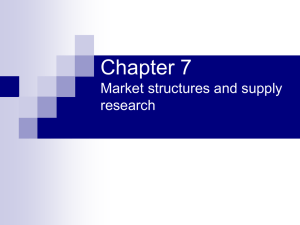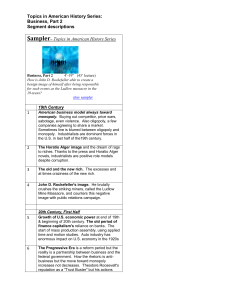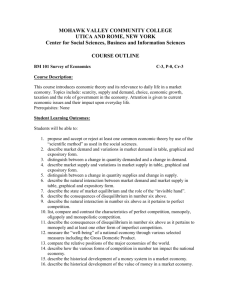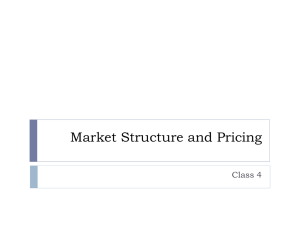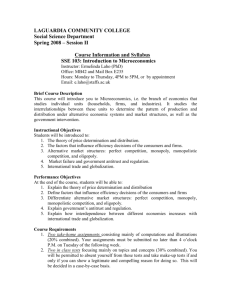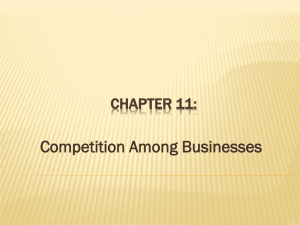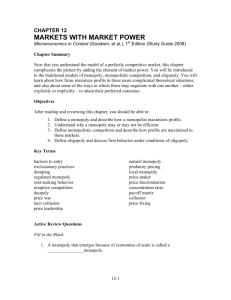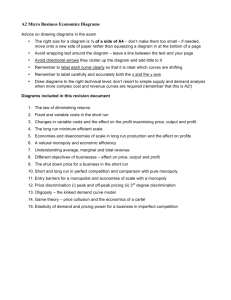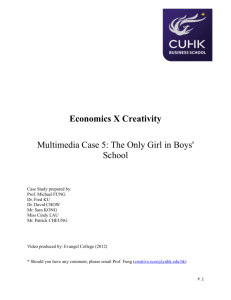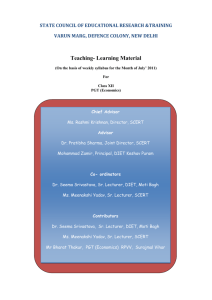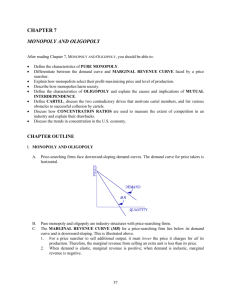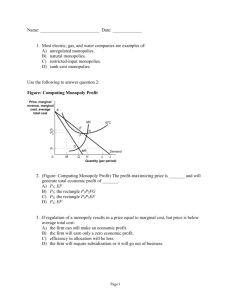The Final Review Sheet (Prof
advertisement
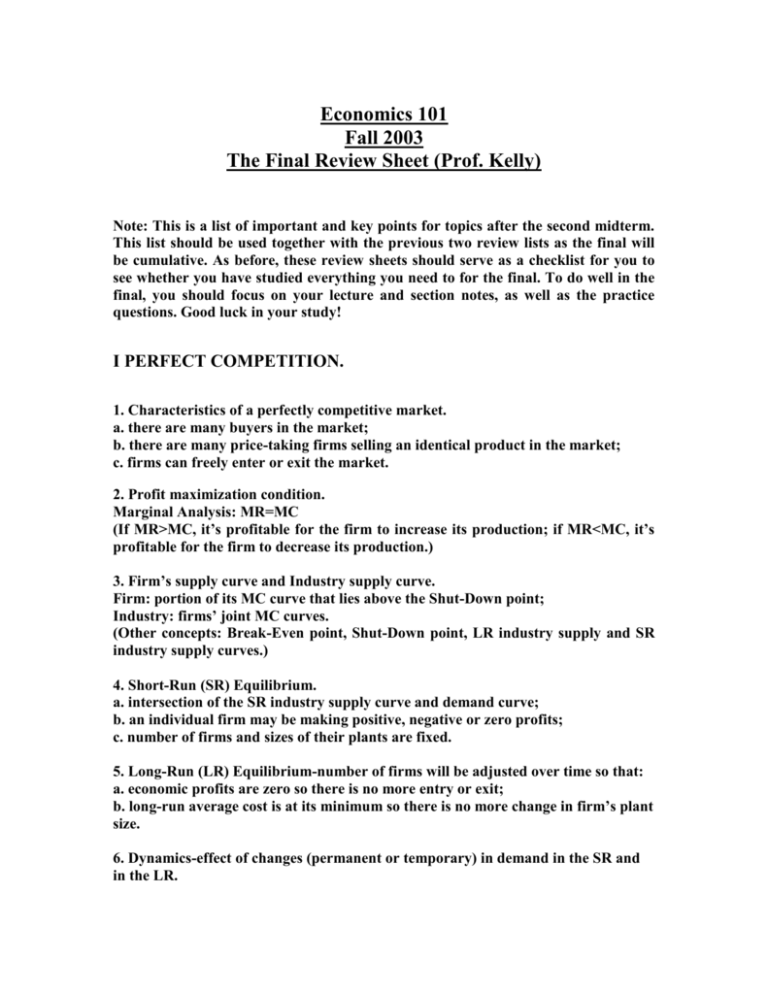
Economics 101 Fall 2003 The Final Review Sheet (Prof. Kelly) Note: This is a list of important and key points for topics after the second midterm. This list should be used together with the previous two review lists as the final will be cumulative. As before, these review sheets should serve as a checklist for you to see whether you have studied everything you need to for the final. To do well in the final, you should focus on your lecture and section notes, as well as the practice questions. Good luck in your study! I PERFECT COMPETITION. 1. Characteristics of a perfectly competitive market. a. there are many buyers in the market; b. there are many price-taking firms selling an identical product in the market; c. firms can freely enter or exit the market. 2. Profit maximization condition. Marginal Analysis: MR=MC (If MR>MC, it’s profitable for the firm to increase its production; if MR<MC, it’s profitable for the firm to decrease its production.) 3. Firm’s supply curve and Industry supply curve. Firm: portion of its MC curve that lies above the Shut-Down point; Industry: firms’ joint MC curves. (Other concepts: Break-Even point, Shut-Down point, LR industry supply and SR industry supply curves.) 4. Short-Run (SR) Equilibrium. a. intersection of the SR industry supply curve and demand curve; b. an individual firm may be making positive, negative or zero profits; c. number of firms and sizes of their plants are fixed. 5. Long-Run (LR) Equilibrium-number of firms will be adjusted over time so that: a. economic profits are zero so there is no more entry or exit; b. long-run average cost is at its minimum so there is no more change in firm’s plant size. 6. Dynamics-effect of changes (permanent or temporary) in demand in the SR and in the LR. 7. Competition and Welfare (Efficiency). Perfect competition is efficient as resources are used efficiently. II MONOPOLY. 1. Definition and fundamental sources of Monopoly. ---Barriers to entry (examples?): a. exclusive ownership of a key resource; b. exclusive right assigned by the government; c. economies of scale; d. threat of force or sabotage. 2. Natural Monopoly. ---arises where it’s more efficient for a single firm to serve the society. (Examples? What will happen if we have more than one firm in the market?) 3. Profit Maximization Condition (for a single-price monopoly): MR=MC. a. The demand curve facing a monopoly is the same as the industry demand curve; b. MC and ATC are similar to those for perfectly competitive firms; c. MR is less than the price: MR<P (why?); IMPORTANT: if demand is linear, P=a-bQ (a, b are positive constants), then marginal revenue is: MR = a-2bQ. (Math: TR=P*Q=aQ-bQ2, MR=dTR/dQ=a-2bQ.) d. The Monopoly can earn an economic profit even in the LR (there is no entry!). 4. Inefficiency of Monopoly. a. Compared to an identical perfectly competitive industry, output is less and price is higher with a monopoly; b. Less output and higher price will result in a loss in Consumer Surplus (CS) and Producer Surplus (PS) ---Dead-Weight Loss (Be careful: does PS have anything to do with the ATC curve?); c. DWL, which measures the inefficiency of the monopoly, is graphically the area between the demand and MC curves for units between monopoly quantity and the efficient quantity. 5. Ways for policy makers to correct the inefficiency. a. antitrust laws; b. regulations (AC regulation and MC regulation); c. public ownership. 6. Price Discrimination--selling different units of a good/service for different prices. a. price discrimination captures some Consumer Surplus and increases the monopoly’s total revenue; b. forms of price discrimination (and examples?). (1) First-Degree price discrimination; (2) Second-Degree price discrimination; (3) Third-Degree price discrimination. III. OLIGOPOLY. 1. Definition---Between Monopoly and Perfect Competition. A market structure where only a few sellers offer similar or identical products. (How is it different from the Monopolistic Competition? Examples?) 2. Oligopolistic Markets. A: Key feature: tension between cooperation and self-interest. a. The group of oligopolists is better off if they cooperate and act like a monopoly --producing less and charging a higher price; b. But every oligopolist has an incentive to act on his own as it cares only about its own profit; ability to cooperate is limited. B: Duopoly: an oligopoly with only TWO members. ---simplest form of oligopoly! C: Collusion; Cartel. 3. Equilibrium for an oligopoly. a. it’s often difficult for oligopolies to form cartels; ---antitrust laws; unstability of cartels. b. Our notion of equilibrium from the lecture; c. when firms in an oligopoly individually choose production to maximize profit, they end up somewhere between perfect competition and monopoly; ---monopoly quantity < oligopoly quantity < competitive quantity; ---monopoly price > oligopoly price > competitive price. d. the size of an oligopoly: an oligopolistic market looks MORE like a competitive market if there are MORE sellers in the oligopoly! 4. Some Game Theory. a. Definition--- a situation where the players or participants' payoffs depend both on own actions as well as on rival's actions.; b. Four elements to describe a game. 1. players; 2. rules: when each player moves, what actions are possible, what is known to each player at the moment they move…; 3. outcomes; 4. payoffs as a function of the outcomes. c. Dominant Strategy; IMPORTANT EXAMPLE: Prisoner’s Dilemma! (Definition? What real-life situations can be represented as a prisoner’s dilemma game?) d. public policy toward oligopolies. ---restraint of trade; ---the Antitrust laws; ---controversies over Antitrust Policy. IV. MONOPOLISTIC COMPETITION. 1. Definition---a market structure where many firms sell products that are similar but not similar. 2. Characteristics: a. Many Sellers; b. Product Differentiation; c. Free Entry. Note: you need to contrast these to those in perfect competition! 3. Short-Run. ---product differentiation gives the seller in a monopolistically competitive market some ability to control the price of its product. 4. Long-Run (free entry). a. price exceeds marginal cost (Why?); b. price equals ATC. ---firms in monopolistic competition also earn zero economic profit as in perfect competition. (Question: why a firm will continue to operate if it is earning “ONLY” zero economic profit?) 5. Monopolistic Competition VS. Perfect competition. a. Excess Capacity; b. Markup over MC. 6. Welfare of Monopolistic Competition. ---inefficiency: a. one source is the markup of price over MC; b. another source is the externality effects from entry (the product-variety externality and the business-stealing externality). V. ASYMMETRIC INFORMATION. 1. Moral Hazard; 2. Adverse Selection; 3. Principle Agent Problem; 4. Ways to Reduce Asymmetric Information.


